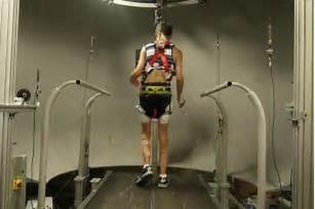
"Columbia University School of Engineering & Applied Science’s Research"
By: Bethany Light
Cerebral Palsy can cause abnormal gait patterns, which causes slow walking, less range of motions, small steps, lots of swaying, and walking on “tip toes”. Some people with CP even have a “crouch gait”, which means while walking, the person looks crouched, with their hips, knees, and/or ankles bent. All of these can cause joint problems, sometimes by late elementary school.
Engineers at Columbia Engineering have been studying how robotics can be used to train muscles to improve posture and walking (published in Science Robotics). Crouch gait is caused by weak extensor muscles and tight flexor muscles, thus limiting joint range of motion and muscles too weak to keep good posture.
"One of the major reasons for crouch gait is weakness in soleus muscles," says Agrawal, who is also a member of the Data Science Institute. "We hypothesized that walking with a downward pelvic pull would strengthen extensor muscles, especially the soleus, against the applied downward pull and would improve muscle coordination during walking. We took an approach opposite to conventional therapy with these children: instead of partial body weight suspension during treadmill walking, we trained participants to walk with a force augmentation."
By: Bethany Light
Cerebral Palsy can cause abnormal gait patterns, which causes slow walking, less range of motions, small steps, lots of swaying, and walking on “tip toes”. Some people with CP even have a “crouch gait”, which means while walking, the person looks crouched, with their hips, knees, and/or ankles bent. All of these can cause joint problems, sometimes by late elementary school.
Engineers at Columbia Engineering have been studying how robotics can be used to train muscles to improve posture and walking (published in Science Robotics). Crouch gait is caused by weak extensor muscles and tight flexor muscles, thus limiting joint range of motion and muscles too weak to keep good posture.
"One of the major reasons for crouch gait is weakness in soleus muscles," says Agrawal, who is also a member of the Data Science Institute. "We hypothesized that walking with a downward pelvic pull would strengthen extensor muscles, especially the soleus, against the applied downward pull and would improve muscle coordination during walking. We took an approach opposite to conventional therapy with these children: instead of partial body weight suspension during treadmill walking, we trained participants to walk with a force augmentation."

Due to the soleus muscle’s role in walking (weight-bearing, straightens knee, and keeps leg in upright position), they reasoned strengthening the soleus might help remedy crouch gait. The team used robotics to provide forces on the pelvis as the subject walks on a treadmill. Over 6 weeks, children (who exhibited crouch gait and were diagnosed with CP) participated in fifteen, 16-minutes sessions. Tension on the pelvis was controlled by a motor on the treadmill and measured by cameras. A downward force of 10% body weight (same as a kid wearing a backpack) was applied. It was the minimum weight to show notable changes in posture or gait during walking.
"TPAD is a unique device because it applies external forces on the human body during walking," says Jiyeon Kang, PhD candidate and lead author of the paper. "The training with this device is distinctive because it does not add mass/inertia to the human body during walking."
Changes in muscle activity and muscle strength were measured during the first and last sessions. Kinematics and such were measured continuously. The training was found to improve upright posture, muscle coordination, and gait features (like step length, range of motion, toe clearance, and heel-to-toe pattern). As there is no current, well-established treatment for crouch gait, this is a promising potential intervention. Clinical trials and further research is in the works.
www.sciencedaily.com/releases/2017/07/170726141638.htm
"TPAD is a unique device because it applies external forces on the human body during walking," says Jiyeon Kang, PhD candidate and lead author of the paper. "The training with this device is distinctive because it does not add mass/inertia to the human body during walking."
Changes in muscle activity and muscle strength were measured during the first and last sessions. Kinematics and such were measured continuously. The training was found to improve upright posture, muscle coordination, and gait features (like step length, range of motion, toe clearance, and heel-to-toe pattern). As there is no current, well-established treatment for crouch gait, this is a promising potential intervention. Clinical trials and further research is in the works.
www.sciencedaily.com/releases/2017/07/170726141638.htm
Siblings with a Mission is a non-profit, international organization established to serve and support siblings of individuals with complex health conditions and developmental disabilities. All images are found on Google images and are solely used for educational purposes. The stories and advice provided by Siblings with a Mission are not to be replaced by professional advice and counseling but to be considered as an additional source of support.
